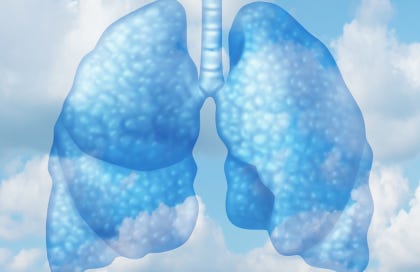Breast Cancer & What You Breathe
Why I hold my nose when I kayak under heavy traffic on bridges!
Air is the new food. There is “healthy” air food and “junk” air food. What you inhale makes its way to your breast tissue, and probably prostate tissue too, but, that wasn’t looked at in this study.
National Institute of Health (NIH) researchers combined historical air quality data with breast cancer data from a large U.S. study. These scientists found that living in an area with high levels of particulate air pollution was associated with an increased incidence of breast cancer.
The study, published in the Journal of the National Cancer Institute, is one of the largest studies to date looking at the relationship between outdoor air pollution, specifically fine particulate matter, and breast cancer incidence. The research was done by scientists at the National Institute of Environmental Health Sciences (NIEHS) and the National Cancer Institute (NCI), both part of NIH. The researchers saw that the largest increase in breast cancer incidence was among women who, on average, had higher particulate matter levels (PM2.5) near their homes prior to enrolling in the study, compared to those who lived in areas with lower levels of PM2.5.
Particulate matter is a mixture of solid particles and liquid droplets found in the air. It comes from numerous sources such as motor vehicle exhaust, tiny tire “goo” that comes off tires from driving on roads, combustion processes (e.g., oil, coal), wood smoke/vegetation burning, and industrial emissions.
The particulate matter pollution measured in this study was 2.5 microns in diameter or smaller (PM2.5). The term fine particles, or particulate matter 2.5 (PM2.5), refers to tiny particles or droplets in the air that are 2 ½ microns or less in width. The largest PM2.5 particles are about 30 times smaller than a human hair. These particles are small enough to be inhaled deep into the lungs.
The Environmental Protection Agency has a website known as Air Now where residents can enter their zip code and get the air quality information, including PM2.5 levels, for their area. I put my city of Austin, TX in and it came out “good”. You should try your home town. Let us know how you rank.
“We observed an 8% increase in breast cancer incidence for living in areas with higher PM2.5 exposure. Although this is a relatively modest increase, these findings are significant given that air pollution is a ubiquitous exposure that impacts almost everyone,” said Alexandra White, Ph.D., lead author and head of the Environment and Cancer Epidemiology Group at NIEHS. “These findings add to a growing body of literature suggesting that air pollution is related to breast cancer.”
The study was conducted using information from the NIH-AARP Diet and Health Study, which enrolled more than 500,000 men and women between 1995-96 in six states (California, Florida, Pennsylvania, New Jersey, North Carolina, and Louisiana) and two metropolitan areas (Atlanta and Detroit). The women in the cohort were on average about 62 years of age and most identified as being non-Hispanic white. They were followed for approximately 20 years, during which 15,870 breast cancer cases were identified.
It takes 5-10 years for breast cancer to develop. If you are breathing in particulate matter all this time, this exposure adds up.
To consider how the relationship between air pollution and breast cancer varied by the type of tumor, the researchers evaluated estrogen receptor-positive (ER+) and -negative (ER-) tumors separately. They found that PM2.5 was associated with a higher incidence of ER+ breast cancer, but not ER-, tumors. This suggests that PM2.5 may affect breast cancer through an underlying biological pathway of endocrine disruption. ER+ tumors are the most common tumors diagnosed among women in the United States.
My Biotics products are all about protection against carcinogenic processes by tamping “down” cancer stem cells and signaling the anti-cancer, protective estrogen receptor, Estrogen Receptor Beta, or ER Beta.
Knowledge is power.
Homes should have extra filtering systems not just the simple filter typically up in the ceiling, such as with IQ Air (see my Products We Love page)or Santa Fe Air. Shower filters should also reduce potential fine particulate matter!
What do you do to filter the air you breathe?
Dr. B.
Reference:
Ambient fine particulate matter and breast cancer incidence in a large prospective US cohort. Journal of the National Cancer Institute. https://doi.org/10.1093/jnci/djad170(link is external)



